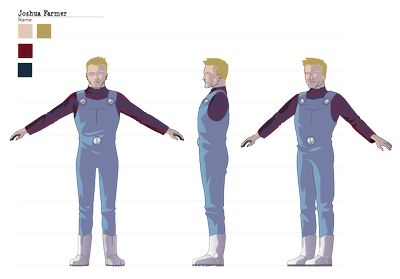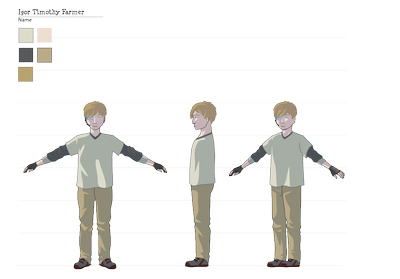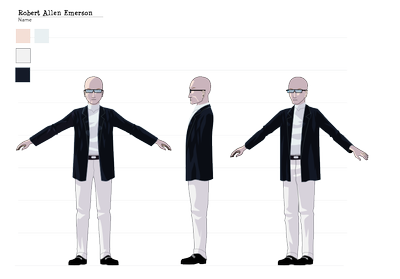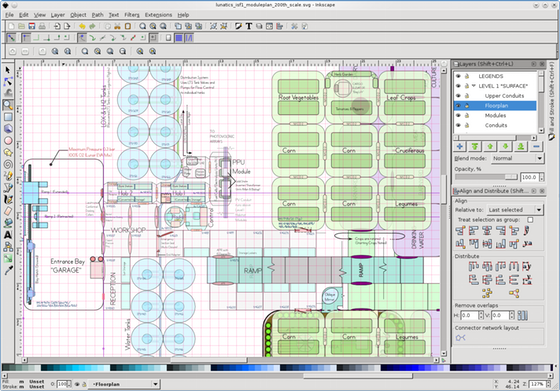We’ve crossed a pre-production milestone — the modelsheets for the eight colonists (our main
characters) are completed. Daniel is now moving on to the artwork for secondary characters. This puts us on schedule for our (recently slipped) delivery goal of early May.
Model Sheets are On Schedule
In my last post, I had to announce a one-month slip. Fortunately, it looks like we are on track to make that goal. I can breathe a small sigh of relief now that the drawings for our eight main characters are done (the last three are below — the previous update includes the other five).
Joshua Farmer
Timothy Farmer
Allen Emerson
Progress on Writing
At the same time, Rosalyn is about halfway through her revision of the script for “No Children in Space”, and she’s also made a start at the script for “Earth” (the 2nd episode). There’s a good chance we’ll be including the “Earth” script in the writer’s guide, too, since they are very different scripts — you might think of them as a statement of intent for the series, bracketing the range of styles we’re looking for. “No Children in Space” goes mostly for the “element of wonder”, with a lot of musical montage and cool stuff to look at. “Earth” focuses more on character humor and dialog.
Of course, it was an intentional decision to make the first episode not rely very heavily on dialog — for a simple production reason: we have no voice actors yet. We hope to use an early revision of “No Children in Space” as a recruiting tool, so I wanted something that would stand up reasonably well with either no voices, or temporary voices done by Rosalyn and myself. So if you’re thinking this is an hour-long music video”, this is why. “Earth” will give an alternative to that.
I should probably add, that, since I’ve already gotten a couple of queries about voice acting, casting may not turn out to be as big of a challenge as I expected, so this may not strictly be necessary. But we’re doing it anyway.
The two episodes together cover more or less the same ground as the short story, “The Arrival” which we’ll also be including in the guide — even though there’s now a lot of “non-canon” material in it due to a large number of changes in characters and setting.
Set Design
I’m close to finishing the floorplan for the colony. There’s still a fair amount of detail work on the “recycling/services” level. This is not really a place we expect to set a lot of scenes, but I do want to have a complete floor plan. Most shows don’t do that, of course, but I figured that since about 90% of our action for the series is going to be inside this one colony set, we might as well make it complete.
What I’ve spent the most time over though recently is the design for the lander. There are a number of tricky conflicts between design goals and technical restrictions. In the end, I’ll probably have to just guess about some things, and hope my aerospace engineering friends won’t roast me too badly!
Lib-Ray
It’s a little bit peripheral, but I also spent some time on a related project, which is “Lib-Ray“.
We’re planning to produce Lunatics in high-definition, but most of our merchandising model is based on DVDs, which are for standard definition video only. Blu-Ray is a bit of a nightmare from a free culture perspective. So I started a project to figure out a standard way to release high-definition video in a fixed format. Early concepts would’ve had Ogg Theora video on BD-R disk. I got stuck on this last Summer, owing to limitations of the software and the available hardware. I got some advice from various parties, and I’ve spent about a week putting together an updated proposal. This will now use a Matroska (MKV) container with VP8-encoded video and Vorbis audio — essentially the same as Google’s “WebM” format. My hope is that Google’s industry muscle will mean a better chance for this format to be supported on hardware platforms (it’s still unclear whether that’s going to work or not).
I’ve also decided to give up on optical media for Lib-Ray. There are too many problems with the existing media. Instead, we’ll move to delivery on flash memory card media — specifically the now ubiquitous SDHC/SDXC standard. These are a lot more expensive than optical disks, but they offer a lot of flexibility. I wrote this up for my latest Free Software Magazine column, so look there for more detail.





